There are health risks to traveling to high altitude. Travelers should consult their physicians for more information..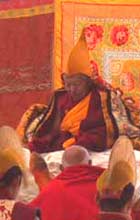
Day One
Lhasa's altitude is about 3,650 meters or 12,000 feet, so we will enjoy a relaxed itinerary over the first days so as to acclimatize to the thinner air. (Sheraton Four Points Hotel) (D)
Day Two
The "land of the snows" has inspired artists for centuries. James Hilton's utopianist "Shangrila" is based on Tibet's monastic communities and devout way of life. To best appreciate Lhasa's palaces, temples and society, we have arranged for a morning lecture to familiarize you with the main themes, characters and symbols of Tibetan art and religious life.
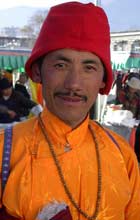 You will be able to apply this knowledge after lunch when we head to the center of Lhasa's religious life at its Jokhang Monastery . It is impossible to put into words the sense of peace and equanimity that imbues the atmosphere of this historic monastery. On the one hand, Tibetan pilgrims display intense devotion as they prey before their deities, pouring yak (a local variety of cow) butter or ghee into the altars' butter lamps. On the other hand, the casual comings and goings of the red-robed monks lend this beautiful building the reliability of tradition and the self-confidence of knowledge. Afterwards, you will stroll onto the Barkhor for the first time. This is the kora , or pilgrimage route around the Jokhang Temple's circumference. As you amble along it, surrounded by pilgrims, you will be assailed by novel sights, sounds and wonders. Poking your nose into local Tibetan markets, your eyes will feast on strangely clad clansmen from Tibet's outlying regions and peruse the wares of the many antique and thangka shops of this astonishing circuit. After a late afternoon rest, we will return here in the evening to watch a Buddhist ceremony in a nearby temple. (B, L, D)
You will be able to apply this knowledge after lunch when we head to the center of Lhasa's religious life at its Jokhang Monastery . It is impossible to put into words the sense of peace and equanimity that imbues the atmosphere of this historic monastery. On the one hand, Tibetan pilgrims display intense devotion as they prey before their deities, pouring yak (a local variety of cow) butter or ghee into the altars' butter lamps. On the other hand, the casual comings and goings of the red-robed monks lend this beautiful building the reliability of tradition and the self-confidence of knowledge. Afterwards, you will stroll onto the Barkhor for the first time. This is the kora , or pilgrimage route around the Jokhang Temple's circumference. As you amble along it, surrounded by pilgrims, you will be assailed by novel sights, sounds and wonders. Poking your nose into local Tibetan markets, your eyes will feast on strangely clad clansmen from Tibet's outlying regions and peruse the wares of the many antique and thangka shops of this astonishing circuit. After a late afternoon rest, we will return here in the evening to watch a Buddhist ceremony in a nearby temple. (B, L, D)
Day Three
Since yesterday should have provided you with some of the most striking visual images of your life, the bar is set high for this morning's visit to the Potala Palace – the trapezoidal, red and white Winter Palace that oversees the growing city beneath. Few buildings are as emblematic of their nation expressing the remoteness and religious might of Tibet. The elaborate golden tombs of past Dalai Lamas are of inestimable beauty, value and mystery.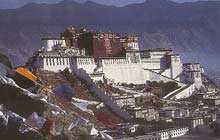
In the afternoon, we return to the center of Lhasa's old town, to the colorful and fascinating Barkhor. We will tour in more detail the incense burners, markers, temples and monasteries that punctuate this sacred pathway and spend more time soaking up the inimitable atmosphere of Lhasa's old quarter. In the evening, we will take in the flavor of Tibetan traditional arts in the form of a musical concert. (B, L, D)
Day Four
This morning we drive to Lhasa's outskirts to visit the grandiose Drepung monastery , at its height the largest monastery in the world with 10,000 monks in residence. Like Oxford and Cambridge Universities in England, also originally monasteries, Drepung Monastery adopted a collegiate system in which to organize its students. Each of the four colleges has a different focus and was famed for a separate area of research. The influential monastic authorities, who had overarching responsibility for the colleges, became an intellectual center of political as well as religious power in Tibet. Two Dalai Lamas are entombed here.
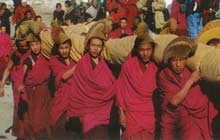 After lunch we will visit a craft studio responsible for making traditional Tibetan carpets. As integral to the quality of a Tibetan carpet as the skill of the weaver is the quality of its wool. Only in rare pockets of the world is it possible to avoid the ubiquitous Merino wool in favor of the more lustrous variety bred in sheep at high altitude. In the late afternoon, we visit Sera Monastery , a traditional rivel of Drepung, to watch the young monks discussing their learning in the Debating Gardens. (B, L, D)
After lunch we will visit a craft studio responsible for making traditional Tibetan carpets. As integral to the quality of a Tibetan carpet as the skill of the weaver is the quality of its wool. Only in rare pockets of the world is it possible to avoid the ubiquitous Merino wool in favor of the more lustrous variety bred in sheep at high altitude. In the late afternoon, we visit Sera Monastery , a traditional rivel of Drepung, to watch the young monks discussing their learning in the Debating Gardens. (B, L, D)
Day Five
Today's day trip to Ganden Monastery , an hour and a half's drive from Lhasa, is an opportunity to replace the city with travel to the rural and mountain areas of Tibet. Thirty miles from Lhasa, we turn our backs on the smooth asphalt of the highway to climb a meandering dirt track up a tributary valley. Our gentle ascent through a series of switchbacks takes us high above the local village to an altitude of approximately 4,500 meters or 14,500 feet. Ganden Monastery, a striking array of white buildings, surrounding the red "Golden Tomb of Tsongkhapa" (the founder of the Gelugpa monastic sect), will suddenly appear in the hollow of a distant mountain ridge. Temples, colleges, dormitories, assembly halls, kitchens and the like proudly dominate the crown of this deep valley.
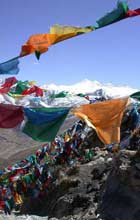 As inspiring as it is to view the treasures of this famous monastery, a visit to Ganden is incomplete without walking its kora , or the pilgrimage around its perimeter. Leading you around the back side of the ridge, thiskora introduces breath-taking views of the river plain thousands of feet beneath as well as of the adjacent, towering, snow-topped mountains thousands of feet above. It is no wonder that chortens (religious towers), prayer flags and prayer stones are sprinkled liberally along this kora in tribute to God and nature. In the late afternoon, we return to Lhasa for a last opportunity to view the structures and enjoy the atmosphere of the Jokhang and Barkhor. (B, L, D)
As inspiring as it is to view the treasures of this famous monastery, a visit to Ganden is incomplete without walking its kora , or the pilgrimage around its perimeter. Leading you around the back side of the ridge, thiskora introduces breath-taking views of the river plain thousands of feet beneath as well as of the adjacent, towering, snow-topped mountains thousands of feet above. It is no wonder that chortens (religious towers), prayer flags and prayer stones are sprinkled liberally along this kora in tribute to God and nature. In the late afternoon, we return to Lhasa for a last opportunity to view the structures and enjoy the atmosphere of the Jokhang and Barkhor. (B, L, D)
Day Six
Today, we leave Lhasa on a morning flight. Since it is customary for a person's metabolic rate to increase with altitude, don't be surprised if you leave Tibet a few pounds lighter than when you arrived!
When To Visit
Lhasa is special any time of the year, however some visitors might think to time their journey here to coincide with either the Tibetan New Year Festival (Feb./Mar.) or the Shoton Festival (late Aug.).
Tibetan New Year takes place in February or March; the exact dates depend on the lunar calendar. It is not particularly cold during this period, the day time temperature rising to about 60°F. At this time, foreign and Chinese tourists are few, whilst many Tibetans come from far afield to auspiciously herald the New Year at Lhasa's temples and monasteries.
The Shoton festival usually takes place in mid to late August, the precise days determined by the lunar calendar. This is also known as the Opera festival, with singing and acrobatics taking place all over town, but most especially in the grounds of the Dalai Lama's Summer Palace, known as the Norbalinka.
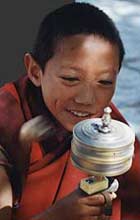 Lhasa is a wondrous place, but customers should be prepared for more basic accommodation than that available in other parts of China. The Lhasa Hotel, the best available, is classed by China's National Tourism Administration as a four star hotel. Depending on your budget and requirements, we can offer various dining options including the services of Imperial Tours' Executive Chef.
Lhasa is a wondrous place, but customers should be prepared for more basic accommodation than that available in other parts of China. The Lhasa Hotel, the best available, is classed by China's National Tourism Administration as a four star hotel. Depending on your budget and requirements, we can offer various dining options including the services of Imperial Tours' Executive Chef.
Imperial Tours does not offer other destinations in Tibet because we do not believe these have facilities appropriate to luxury travelers.
Please note that B, L, D denotes Breakfast, Lunch Dinner.
The above Lhasa tour itinerary is arranged on a private basis only. Visitors interested in a group tour of China, should view our frequent Imperial Tour itinerary.
 Day One
Day One
you will fly to Huangshan City, arriving in the evening where you will check into its finest hotel. (Huangshan Pine Golf Hotel – Duplex Suite or Executive Suite, subject to availability)
Day Two
Waking up early to take full advantage of your day on the Yellow Mountain, you will be immediately driven from Huangshan City to the mountain itself. Having ascended three-quarters of the rugged mountain by cable car, you will still need to hike uphill for another 45 minutes before arriving at Huangshan's circuitous peak. For the next two or three hours you'll want to stroll around the peak appreciating its dramatic views. Depending on the weather, you may enjoy views of granite tusks suddenly piercing through the swirling mist, or else if it's colder, will be delighted by the famous seas of pink-tinged clouds floating between Huangshan's jagged ridges.
In early/mid-afternoon, it will be up to you to decide whether to descend by foot or by cable-car. The walk down is demanding, but then again these views can be the most sensational. (B, L, D)
Day Three 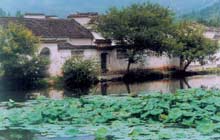
This morning you will tour some ancient, picturesque villages, conveniently located near Huangshan City. Commonly, it is the remote geography of such villages that has harbored them from the destructive force of China's turbulent history . This visit, then, will be a rare opportunity for you to experience at first hand the design and architecture of well-preserved, affluent Ming Dynasty (1368-1644) villages. Apart from enjoying curious architectural details, such as a wind shield covering a six hundred year old "window", you will also be able to appreciate the sheer ingenuity of traditional urban designs, maximizing the use of running water for aesthetic, spiritual and practical benefits.
In the early afternoon, you will return to Huangshan to walk through its ancient city quarter, which features a centuries old, double-tiered shopping street, packed with intriguing wares. As evening approaches you will be whisked to the airport, from which you will return by plane to Beijing. (Peninsula Palace Hotel – Executive Suite or St. Regis Hotel – Executive Deluxe Room (B, L, D)
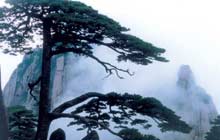
Day Four
A car will drive you to Huangshan airport in time for your plane home. (B)
Please note that B, L, D denotes Breakfast, Lunch Dinner.
Huangshan tours are arranged on a private basis only. Visitors interested in a group tour of China, should view our frequent Imperial Tour itinerary.
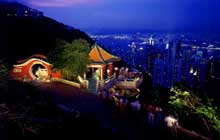 Victoria Peak
Victoria Peak
If you picture Hong Kong as a dragon, with qi or energy coursing through it, then Victoria Peak is the summit of the dragon's spine; and the Peak is unquestionably Hong Kong 's premier tourist site. If you visit in summer you'll no doubt sympathize with Sir Richard MacDonnell, a Governor of Hong Kong in the nineteenth century, who moved his residence there to avoid the tropical torpor down by the harbor. Since Sir Richard's day a few more buildings have gone up and it is no longer a simple look-out, but a multi-storey complex of shops, restaurants, and a Madame Tussaud's waxworks (with Jackie Chan, of course). But it's the view that one goes for. Day or night the vista over the harbor, with the buildings slowly crawling up the hill toward you, is breathtaking. You can drive to the Peak, or join many other tourists on the funicular (a cable railway with two cars balancing each other as they move in opposite directions) that runs at such an angle that it is difficult to believe that Hong Kong 's buildings are vertical and not shooting out at all angles. From the terminus you can take the escalators to the top viewing platform.
Government House
Built in 1855 and extended by the Japanese during their four years of rule in Hong Kong this charming neo-classical building served as the residence for 25 of Hong Kong 's Governors. When the British left in 1997 the building was abandoned, but beginning in 2006 the building resumed its purpose. Now it once again houses Hong Kong's political leader, this time the Chief Executive of the SAR who would, no doubt, sympathize with the sentiment of the British Governor of 1919-25, Sir Reginald E Stubbs, who advised keeping any leanings of the local population toward democracy 'within the bounds of reason'. It remains to be seen whether it will host the luminaries it has in days gone by, counting among its visitors the yet to be crowned Tsar Nicolas II, and the former US President Ulysses Grant.
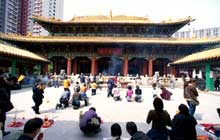
The Tin Hau and Man Mo Temples
One of the most striking facets of Hong Kong is that a city that appears so thoroughly modern preserves so many small temples and functions as one of the de facto centers of the Chinese art of Feng Shui. The two worlds may not be as separate as they appear and many of Hong Kong 's landmark buildings have been designed with feng shui principles in mind. None of the buildings, however, can compete with a site near the Lung Cheung Road Lookout, on the Kowloon Peninsula , where they say the dragon energy that has ensured Hong Kong 's success is thickest. To get a feel for the original culture that flourishes yet in Hong Kong then visit a Tin Hau or Hung Sin Temple, both being gods of the sea. The Tin Hau Temple in Causeway Bay , built initially in the early eighteenth century, is still in the hands of the family who put it up. Just around the corner is the Lotus Temple – a terrific example of a small local temple where if you back up to admire the view you'll bump into a pillar. The Lotus Temple has monks, the delightful coiled cone incense, and is a fine place to see how ancestor worship, religious worship, and scholarship all come together – in this Buddhist temple, in the spirit of Pascal's Wager, there is also a statue of Confucius in one of the side temples on the way up. The best-known Daoist temple is the Man Mo Temple, a Hong Kong landmark that is popular with everyone, regardless of whether they are Daoist or not. The Temple was constructed during the middle of the nineteenth century and dedicated to the twin gods of literature and the martial arts – a telling sign of how important those two attributes became in Chinese culture is that positions in the imperial governments were often divided along those lines; and if you place the Chinese characters for 'literature' and 'martial' side by side the resultant character means refined.
The Outlying Islands
If you feel like escaping the concrete and skyscrapers in search of an older Hong Kong then the outlying islands make for an interesting experience. Many preserve a way of life that is almost unimaginable amidst the offices in Central. From Cheung Chau with its still functioning fishing village to Lantau with its exhilarating walks on well-defined trails, and quaint villages. The scenery can be stark on the slopes yet tropically lush by the shore – wherever you walk you'll soon enough come face to face with the realization that Hong Kong 's extraordinary growth has come about despite lacking supplies of fresh water and arable land. Lantau is also home to the largest Buddha in the area, known unsurprisingly as the Big Buddha, which can now be visited via an extraordinary cable-car journey that begins near the airport and winds its way for nearly 6km up to the Po Lin Monastery. In a curious Western juxtaposition, that Hong Kong seems so good at throwing up, Lantau boasts both a Disneyland and a Trappist Monastery; the latter used to make fresh milk, known as 'Priest Milk', on site.
 Just to the south of Hong Kong lies Macao. This tiny territory of just under thirty square kilometres must be one of the few places in the world where a former colony boasts a higher per capita income than the parent country. Macao was settled while the Portuguese were acting as middlemen for trade between the Chinese and Japanese during the sixteenth century. These days it is internationally known for the casinos, whose revenues now better those of Las Vegas , but beneath that all-encompassing industry a small segment of Europe has lived on inside the Chinese world.
Just to the south of Hong Kong lies Macao. This tiny territory of just under thirty square kilometres must be one of the few places in the world where a former colony boasts a higher per capita income than the parent country. Macao was settled while the Portuguese were acting as middlemen for trade between the Chinese and Japanese during the sixteenth century. These days it is internationally known for the casinos, whose revenues now better those of Las Vegas , but beneath that all-encompassing industry a small segment of Europe has lived on inside the Chinese world.
The British poet, Auden, visited many years ago and wrote a poem which began:
"A weed from Catholic Europe, it took root
Between the yellow mountains and the sea,
And bore these gay stone houses like a fruit,
And grew on China imperceptibly."
And finishes with a line that Auden presumably meant as a slight "And nothing serious can happen here", but which may have helped preserve some of the charm and tastes of the Portuguese world. These range from the ruins of the Church of St. Paul and a cemetery through which you can trace the history of the settlement, to the foods be they simple bread or substantial Macanese fare.
Some of the numerous gaming revenues that the small territory which, like Hong Kong , has reverted to China , has been put to good use in providing public services and expanding the university.
 Day One
Day One
You will land at Hong Kong 's new international airport. This was Britain 's last infrastructural project before handing over this dynamic commercial hub to China in 1997. Since then, despite fears to the contrary, this financial center of dizzying contemporary architecture, perched on a tiny tropical atoll in the South China Sea , has retained its potency as the major gateway to doing business in China.
After transferring to your beautiful hotel, if there is time you might like us to book you a treatment at the hotel's lovely spa. This evening, you may enjoy one of our recommended restaurants for your evening repast. (Peninsula Hotel)
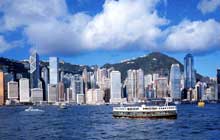 Day Two
Day Two
We usually leave the time free for you to explore Hong Kong on your own. Some will wish to dash to one of the famously efficient Bombay tailors for a suit. Others will saunter along Hollywood road to peruse the antique shops. Many will walk the second floor shopping mall walkways of Hong Kong amazed that they are so well-linked and somewhat shocked that any one place can justify so many luxury brand stores. Should any traveler require more customized services in Hong Kong , such as a specialist in jade or ceramics, please see some of the options below.
Day Three
Today you will leave the architectural and commercial hubbub that is Hong Kong . If you have enjoyed your hotel and have eaten and shopped well, then you surely have taken advantage of Hong Kong 's delights.
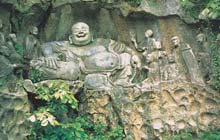 Lingyin Temple, or the Temple of Inspired Seclusion, was founded in 326 AD by the Indian monk, Hui Li. It quickly became a center of worship for the Chan (Zen) Buddist sect, and once served as home to more than three thousand monks. During its turbulent history the temple has been destroyed and then restored no less than sixteen times with the current structures dating to the late Qing dynasty (1644-1911).
Lingyin Temple, or the Temple of Inspired Seclusion, was founded in 326 AD by the Indian monk, Hui Li. It quickly became a center of worship for the Chan (Zen) Buddist sect, and once served as home to more than three thousand monks. During its turbulent history the temple has been destroyed and then restored no less than sixteen times with the current structures dating to the late Qing dynasty (1644-1911).
Before reaching the temple however, you will pass a series of rock carvings on the "Peak that Flew from Afar". This was named in honor of the Indian monk, Hui Li, who commented that the mountain looked exactly like one in India. Between the tenth and fourteenth centuries, this peak's rock surfaces were carved with over three hundred Buddhist statues. One of the most famous is that of the Laughing Buddha, known as the Maitreya or the Buddha of the Future. Dedicated to him is a couplet which reads,
"His belly is big enough to contain all intolerable things in the world;
His mouth is ever ready to laugh at all snobbish persons under heaven."
It is believed that if you rub the belly of this Buddha, he will be able to foretell your future and make your wishes come true.
Lingyin temple, like many Chinese temples, is constructed according to a basic pattern. Built on a north-south axis with the main entrance to the south, it is surrounded by a protective perimeter wall. The main entrance, secured by heavy gates, is guarded by sculptures of the Four Guardian Warriors-protectors of the temple.
Standing behind these is a short spirit wall – this prevents direct entry to evil spirits, which are said to travel in straight lines. Circumambulating it, you will find yourself in a courtyard on the far side of which stand several enormous bronze vessels. These continue to be used to burn either incense or paper offerings to the gods.
Behind them is the first temple pavilion, usually elevated from the courtyard by a short set of steps. In front of the main Buddha stands an altar piece hosting such objects as candle holders, incense burners and an offering plate containing fruit, money and even candy. At Lingyin Temple, the central statue is an eighteen foot high statue of Sakyamuni, or the Historical Buddha, made in the Tang dynasty (607-960). Carved out of twenty-four pieces of camphor wood, it is said to be one of the largest wooden Buddhas in the world.
Typically this representation of the Buddha includes a glass ball on his forehead representing the eye of wisdom, long earlobes which portend longevity, the thumb-middle finger gesture signifying strength and wisdom, a lotus pedestal associated with purity (since the flower emerges unstained from the mud), and the nimbus behind his head which signals brightness. On this nimbus are carved the "seven ancient Buddhas" who symbolize the seven gems (gold, silver, glaze, glass, coral, agate and the conch shell) as well as the seven human emotions (joy, anger, melancholy, fear, love, hate and desire).
To proceed to the next courtyard you should walk to the back of the pavilion where an exit door, guarded by another deity, awaits you. Depending on the size of the temple complex, the number of successive courtyards will vary, with the most important buildings set deep into the complex so as to ensure ample protection from evil spirits.
 Day One
Day One
Hangzhou is a city whose reputation for beauty is encapsulated by a famous Chinese couplet: "In heaven there is paradise, On earth there is Hangzhou and Suzhou". You will arrive at your hotel situated by the famous West Lake. Depending on what time you arrive, you may wish to take a stroll around the lake or have a meal, sampling some of the local casserole and seafood delicacies. (Hyatt Regency Hotel) (D)
Day Two
It was Hangzhou whose wealth and splendor flabbergasted Marco Polo. Your visit begins exactly as he recommends, with a tour by gondola of the West Lake's elegant causeways and landscaped islands. Back on land, we repair to the verdant fields of nearby Longjing to learn about tea. The tea ceremony, exported to Japan during the Tang dynasty (618-907), has links to Daosit and Buddhist practice. Your senses will be enthralled by a variety of teas, each with its unique teaware and ceremony. This evening's banquet combines a similarly breath-taking setting with the unforgettable delights of Hangzhou's delicious cuisine, arguably the finest in China. (B, L, D)
Day Three 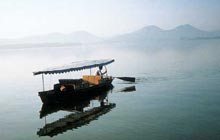
For those who wish to do so, we will be setting off extra early to watch the early morning exercises taking place at this time by West Lake. After breakfast, we will visit Lingyin Temple to view not only a historic temple, but also to inspect the astounding sculptures of its Buddhist monks.
Please note that B, L, D denotes Breakfast, Lunch Dinner.
Hangzhou city tours are arranged on a private basis only. Visitors interested in a group tour of China, should view our frequent Imperial Tour itinerary.
 Day One
Day One
Arrive at the Hotel of Modern Art and enjoy a relaxing meal or a stroll through the tiny, pedestrian streets of Yangshuo village. (Hotel of Modern Art – Deluxe Room) (D)
Day Two
In the morning we will take a relaxing boat-ride along a rarely visited stretch of the Li River: fishermen use cormorants to fish, clumbs of bamboo trees line the shores, buffalo wallow in the shallow water, children play beside their father, who rake the river bed for reeds. After lunch, you will have the opportunity to explore traditional village life – visit a local school, take part in preparing soy milk, or just wander through the rice fields. (B, L, D)
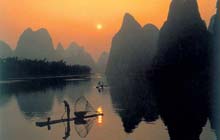 Day Three
Day Three
What you do this morning is entirely up to you. You might wish to rent a bike, explore the local market, visit a nearby park or simply sit at a café and watch the world go by. (B)
Please note that B, L, D denotes Breakfast, Lunch Dinner.
The above Guilin tour itinerary is arranged on a private basis only. Visitors interested in a group tour of China, should view our monthly Imperial Tour itinerary.
Day One
At the end of our flight, the oasis town of Dunhuang appears unexpectedly in the midst of a seemingly infinite sandy desert. After landing here in the late afternoon, we will check into the Sun Villa Hotel. Tonight, dinner will be served al fresco in the hotel's spacious gardens (weather permitting). (Silk Road Hotel – Deluxe Suite) (D)
Day Two 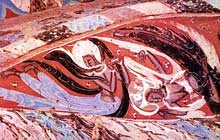
The day starts at one of the world's most impressive cultural heritage sites, the Mogao Caves . Comprising over 400 caves of paintings and sculptures, dating from the fourth to thirteenth centuries, the Mogao Caves are a store of history as much as they are of beauty. Documented amongst the murals are the expeditions of such legendary journeymen as Zhang Qian , the brave expeditioner who first recounted the potential of the Silk Road and Xuan Zhang , the devout monk who imported the first Sanskrit Buddhist texts to China from Northern India. (For most guests, a morning at the Mogao Caves will suffice. Others, however, may wish to spend the whole day exploring the caves.)
After a lunch of local delicacies, we will voyage northwest across the stony desert to Jade Gate Pass (or Yumen Guan), built in the second century BC during the Western Han Dynasty. Named after the high quality jade imported to China from Khotan, 800 miles to the west, the Jade Gate Pass – China's westernmost border crossing – indicated to the weary trader that his eastward journey to China's capital was just under half-complete. A nearby relic from this period is an early remnant of the Great Wall . To enthusiasts, what is most fascinating about this 2,100 year old section is the construction materials used to build it – layers of stamped earth, sand, straw and brushwood. (B, L, D)
Day Three 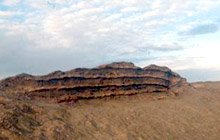
This morning, we will take a camel ride to watch the sun rise over the Mingsha Sand Dunes. There, sitting above the "singing sands," we will breakfast (weather permitting). Before heading to the airport to return to Beijing, there will be time to visit the White Horse Pagoda, built in tribute to the horse of the famous monk- translator Kumarajiva. (B, L)
Please note that B, L, D denotes Breakfast, Lunch, Dinner.
Dunhuang tours are arranged on a private basis only. Visitors interested in a group tour of China, should view our frequent Imperial Tour.
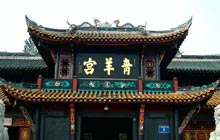 Qingyang Temple , which literally means Temple of the Dark Ram, is the most exquisite and active Daoist temple in Chengdu . The name is associated with many myths, such as Laozi (the mythical founder of Daoism) claiming that he would be reborn in a market where dark rams were sold, to a meeting of Daoist luminaries at which some dark rams were seen. Whatever the truth of the name, it was acquired in the ninth century after some remarkable phenomenon led to the unearthing of a box which contained a seal on which ancient characters with a Daoist message were carved. The temple has halls devoted to a number of luminaries in the Daoist firmament including Lao Zi, one of the trinity of the highest deities in Daoism; but also features halls with the Jade Emperor who ranks as the senior of the Heavenly Emperors, and other lesser deities. If you see religious or spiritual activities taking place that you might think belong elsewhere do not be too surprised. While Daoism does have its own gods and texts it has always been more open to other influences and will absorb ideas we might otherwise associate with Confucianism, Buddhism, or folk religion much more easily than other creeds will.
Qingyang Temple , which literally means Temple of the Dark Ram, is the most exquisite and active Daoist temple in Chengdu . The name is associated with many myths, such as Laozi (the mythical founder of Daoism) claiming that he would be reborn in a market where dark rams were sold, to a meeting of Daoist luminaries at which some dark rams were seen. Whatever the truth of the name, it was acquired in the ninth century after some remarkable phenomenon led to the unearthing of a box which contained a seal on which ancient characters with a Daoist message were carved. The temple has halls devoted to a number of luminaries in the Daoist firmament including Lao Zi, one of the trinity of the highest deities in Daoism; but also features halls with the Jade Emperor who ranks as the senior of the Heavenly Emperors, and other lesser deities. If you see religious or spiritual activities taking place that you might think belong elsewhere do not be too surprised. While Daoism does have its own gods and texts it has always been more open to other influences and will absorb ideas we might otherwise associate with Confucianism, Buddhism, or folk religion much more easily than other creeds will.
The Temple has a public sphere and a more private section where the monks live and practice. The grounds are well-manicured and extensive, and most of the present buildings in the complex date back to the seventeenth century. You can begin your visit with a rub of the ram statue for good luck and then go through to the main halls of worship. To get a good feel for how Daoist philosophy and indigenous Chinese folk religion are all mixed here together don't miss: the signs of the eight trigrams on the Bagua Ting (Pavilion of the Eight Trigrams); the 81 dragons referencing Chinese numerology; and the worshippers in the main hall shaking stalks out of a wooden cone. Once a stalk falls out, the worshipper takes it to a side room where a Daoist Priest exchanges it for an appropriate reading to the silent question the worshipper has asked. If you're feeling lucky then shake a stick yourself or try to throw some coins onto your Chinese zodiac sign.
In addition to the wide-ranging philosophical and folk references within this sanctuary of Chinese thought, there is an impressive array of traditional Daoist activities. Alchemy, once hotly researched here, is related in its exploration of physical and biological laws to the temple's long-standing traditional Chinese medicine practice. The benefits of meditation are combined with precise muscular control in the artful exercise of taiqi as taught by the temple's resident master. The temple's tea ceremony is refined and developed in the same room used by its Daoist orchestra. The combination of richly varied ideologies, images, practices and arts seen in a visit to the Qingyang Temple feels like a celebration of some of the most original and intriguing aspects of traditional Chinese culture.